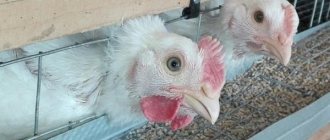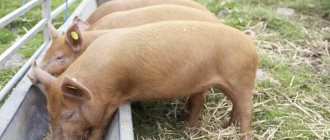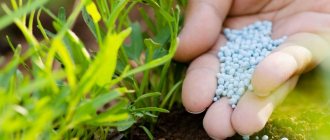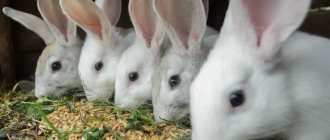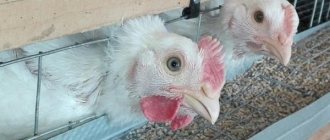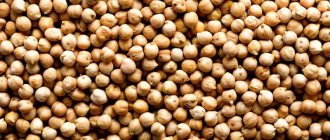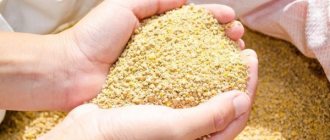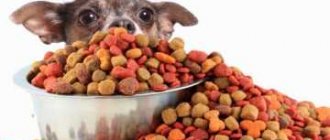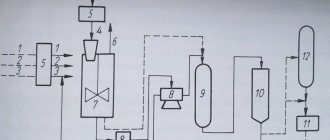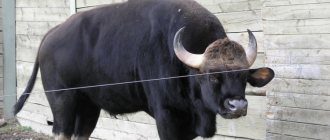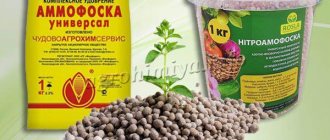What does compound feed for cattle consist of?
When choosing feed for cows, you should consider some points:
- breed;
- age;
- biological condition;
- purpose of content;
- performance.
Each individual type of feed contains components that are selected in accordance with the needs of livestock at a certain moment.
The main part of any mixture is allocated to grain crops: wheat, oats, barley, corn, etc. The grain included in the feed helps to increase weight and supplies the animal with energy. This causes the cow's components to gain weight. Grain is the carbohydrate component of feed. In addition, it is rich in vitamins, micro- and macroelements, which must be taken into account when calculating the proportion of grain in a particular feed.
The protein component of the mixture is represented by peas, forage legumes and sweet lupine. These products contain crude protein, which is especially important for dairy animals.
A more capacious source of proteins is meal. When producing compound feed, soybean, rapeseed or flaxseed are used.
Soybean meal is the fibrous part of soybeans obtained by extraction and contains approximately 5% fat. In addition to its main functions - supplying animal protein to the body - this product is rich in vitamins and minerals:
- copper;
- calcium;
- phosphorus;
- gray;
- magnesium;
- potassium;
- manganese;
- zinc;
- cobalt;
- iodine;
- vitamins A, D, E, group B.
Soybean meal is often used in the production of compound feed, which is explained by its easy digestibility, energy intensity, and high nutritional value. In addition, feed with this component promotes rapid weight gain in livestock and strengthens the immune system. In addition, many cows are happy to eat feed containing soybean meal, since it has a pleasant aroma for them.
Although such products have some disadvantages, since soybean meal is a by-product obtained during oil extraction production, and during extraction a substance dangerous to the body is used - hexane, the prolonged use of which can cause intoxication of the animal.
In addition, poisoning is possible when low-quality raw materials are used in the production process of feed or technology is violated. To avoid such problems, experts do not recommend introducing soybean meal into feeds too often, and sometimes replacing it with legumes.
Rapeseed meal is also rich in protein, vitamins and minerals. The protein included in its composition is close in quantity to soybean meal. Thanks to this product included in the mixed feed, milk productivity increases and the characteristics of milk improve. Rapeseed meal is characterized by a relatively high fat content, due to which this additive is considered universal. Most often, feed containing such a component does not contain vegetable oils at all or contains only a small amount.
Flaxseed meal is also characterized by the presence of certain features. In addition to the traditional qualities of this component, it also has a dietary effect. During the process of swelling in water, mucus is released from the flaxseed meal, which helps coat the walls of the intestines and protect it from irritation. Although this product also has disadvantages - too much flaxseed meal in the feed can lead to intoxication of livestock with dangerous elements.
Thanks to the sugar contained in the feed, animals eat such food with pleasure, and dairy products from dairy cows acquire more pleasant taste. But sugar in the diet of cattle should be present in limited quantities. So the best option is to introduce this substance into the diet as part of mixed feed, since this product contains sugar in the correct dosage.
Important! Thanks to the yeast included in the feed, the animal grows and develops faster, and this also helps to increase productivity.
The salt content in the feed helps maintain normal metabolic processes in the body of cattle, has an antibacterial effect, and also improves immunity. This is especially important during the cold season.
To achieve maximum results, the main components can be supplemented with premixes. A premix is an artificial additive, the composition of which is developed taking into account the needs of cows, and in a certain dosage, which is an advantage of this product in comparison with natural additives.
To saturate the cattle's body with calcium, chalk is added to the feed. This substance helps in the formation of bone structure, improves the functions of the immune and nervous systems. In addition, if there is a lack of calcium, there is a risk of reproductive dysfunction in animals of both sexes.
Various formulations
The use of mixed options increases the efficiency and productivity of any individual by 10-12%. Improvement with vitamins and stimulants enriches the nutritional value of food by 25-30%.
The main substance in the compositions is grain feed. What is compound feed is approximately 60-65% of different crops. For example, a little:
- oats;
- barley;
- corn;
- wheat;
- millet
The main feature of the compositions is the high content of carbohydrates - 65% and a small amount of protein - 15%. Protein compositions are made with the inclusion of:
- legumes;
- peas;
- soybean crops.
They contain up to 50% protein. Another composition option involves the addition of oilseed elements. They are made from sunflower, cotton, and rapeseed seeds. The type is cereal, flour or granules.
A separate gradation of feed takes into account the age of the animals. For calves there are options:
- from 10 to 70 days from birth;
- from 71 to 116;
- from 117 to 400;
- 1-6 months;
- 6-12;
- 12-18.
Important
Young animals are sensitive to the quality of food, so you need to select it very carefully. The main diseases of calves are associated with the performance of the gastric system. Pathogens that cause disease get there with food. For small bulls, it is best to choose starting feed additives, which in most cases are called that. Starters are given in doses, the initial norm is 150-200 g. per day. The volume gradually increases and by 6 weeks of age it should be approximately 2.5 kg.
The most famous folk supplement is Hercules porridge.
It is not recommended to serve all factory versions dry. These are usually liquid jelly and porridge. Homemade supplement formulations are made from:
- barley - 40%;
- oats - 30%;
- ground wheat - 10%;
- seed cake - 10%;
- salt and chalk - 0.1%.
Additionally, they are enriched with premixes. If veal feed is prepared at home with your own hands, you will need a crusher. The device is equipped with a hopper with a capacity of approximately 20 kg and a motor with a power of 1-1.2 kW. The cost ranges from 15-20 thousand rubles.
Combined additives are produced for dairy cattle, which include:
- corn - 15%;
- barley - 20%;
- sunflower - 25%;
- bran - 15%;
- herbal flour - 25%.
A good component in compound feeds is ordinary salt and chalk. According to the standards, for 200-300 kilogram cows you need 4-5 kg of mixture. Cattle weighing up to 600 kg need 10 kg of names per day.
Advantages of using mixed feed for feeding cows
The widespread use of compound feed on livestock farms is justified. Without a doubt, the use of natural feed is an excellent option for livestock, but for farmers engaged in mass breeding of cows for meat and dairy products, as well as offspring, artificial feed is an integral part of the animal's diet.
The main advantage of compound feed is that the livestock breeder knows exactly what components it contains and in what dosage. With certain knowledge regarding the needs of livestock at specific points in life, the livestock breeder is able to adjust the diet, taking into account the circumstances, age and breed of cows.
An important advantage of compound feeds compared to natural food is their cost-effectiveness. This product is a concentrate, so the animal needs to be given it in smaller quantities than natural feed.
Animals happily eat such food and do not leave anything in the feeder. In addition, when storing them, no special rules are required, which simplifies the use of the product.
Pros and cons of feed mixtures for cattle
The use of mixed feed for use in cattle diets has a number of positive aspects. These include:
- Ease of operation, storage and transportation.
- Cost-effective compared to traditional feeds.
- Balance, the ability to include the necessary elements.
- Environmental friendliness, safety in terms of compliance with sanitary and hygienic standards.
- Possibility to give food any form (pellets, powder, briquettes).
Feeding cattle with compound feed provides better results compared to conventional feed; herd productivity increases by an average of 10-15%. Thanks to balanced nutrition, strong livestock grow and healthy offspring with good immunity are born. The disadvantages of using feed for cattle are the following:
- Higher price compared to conventional feed.
- It is necessary to accustom animals to such a diet from a young age, since adult livestock may not accept such food after the traditional one.
- The complexity of self-production, the need to use special equipment.
- The need for constant monitoring of feed dosages.
In what forms is feed for cattle produced?
Compound feed is produced in several forms, which allows each farmer to choose the most suitable one, taking into account the needs of the animals and their own preferences. Today on the market you can purchase combined feeds in the form of:
- Loose feed is a relatively homogeneous mixture of crushed ingredients. The level of grinding can be fine, medium or coarse. The production of this type of feed requires little expense, so this feed is the cheapest.
- Pelleted feed. This type of product is obtained by pressing crumbly feed. It is a cylindrical granule with dimensions of 5-19 mm. Such feed is much more convenient to store and transport; it can be fed into cow feeders using a mechanized method, which is important for large livestock farms. In addition, pressing the feed helps reduce the likelihood of pathogenic microorganisms penetrating into it, and the elements contained in the combined feed become more easily digestible, while the amount of vitamins remains unchanged.
- Briquetted combined feed. This form is most convenient for use in large-scale livestock farming. This feed is produced in the form of relatively large pressed bars. Thanks to this, this product is very convenient to transport and store. But, before pouring such food into animal feeders, it must be crushed.
What is compound feed?
All compound feeds are divided into several groups depending on the form of release. They can be of the following types:
- loose;
- granular;
- briquetted.
If we talk about the first type of feed, then this is an almost homogeneous mixture, in which the components were purified and crushed to the required size. This includes food familiar to cows:
- cakes;
- hay;
- straw;
- corn;
- legumes;
- bone flour;
- vitamin and mineral complexes.
They are combined according to the recipe in the required quantity. There are three types of grinding: fine, medium, coarse.
Granular feed is prepared from the loose composition, which was described above, using a special device - a granulator, which acts like a press with high pressure. The result is a large fraction called granules. They are cylindrical in shape and have the same dimensions.
Types of feed
If we compare loose and granulated feed, the second will have the following advantages:
- convenient transportation and storage;
- ideal for use on farms with automated feed distribution;
- the components included in the composition are not subject to mechanical stress and cannot self-sort;
- during feeding, granules are used more sparingly, they practically do not spill out of the feeders;
- nutritional components are more easily absorbed by the body;
- Thanks to additional processing, pathogenic microorganisms that could be in the original sources of raw materials are destroyed.
Briquettes are produced using almost the same technology as granules, but have a larger shape. They can be of different sizes. These feeds are based on hay and straw, accounting for at least ½ of all components. Molasses helps give the briquette its shape. A small disadvantage of this type is that it is crushed before distribution to animals.
Combined feeds for young animals
The use of high-quality combined feed of the “Start” type for feeding young animals in the future makes it possible to increase the production characteristics of animals by 12% (when compared with other representatives of cattle whose diet consists of other feeds). The most popular combined feed for calves consists of the following components:
- wheat grain - at least 20% of the total composition;
- wheat bran – 20%;
- barley grain – 20%;
- oat grain – 10%;
- mineral additives: 1% calcium phosphate, table salt, crushed limestone.
A fairly suitable base for such products is sunflower meal. Oats can be replaced with wheat or barley, and you can also use corn or millet. When the calf reaches 42 days of age, silage or stillage must be added to the combined feed. These components have a positive effect on the formation of the body of young cattle.
Young animals of this age need carbohydrates, the volume of which should be 70%. The amount of protein in the diet should be a maximum of 15%. This proportion was chosen purposefully. A growing body requires large quantities of energy, which is supplied to the body during the processing of carbohydrates.
What is included in the feed
As a rule, basic feeds do not differ much from each other in their composition. The following table shows three different options.
| Component name | Recipe No. 1 (content in percentage) | Recipe No. 2 (content in percentage) | Recipe No. 3 (content in percentage |
| wheat grain | 25 | 20 | 21 |
| Winter barley grain | 31 | Not added | 20 |
| Corn grain | Not added | 20 | Not added |
| Sunflower meal | 10 | 10 | Not added |
| Soybean cake | 30 | 20 | 10 |
| Feed chalk | 0,5 | 0,5 | 1 |
| Mineral supplements | 3 | 3 | 3 |
| Soybean oil | 0,5 | 0,3 | Not added |
| Dry beet pulp | Not added | 26,2 | Not added |
| Pea grain | Not added | Not added | 45 |
You can use any type of grain, not just those listed in the table.
Compound feed for mature cows
Combined feed for mature cattle is slightly different from mixtures intended for feeding young animals. These products contain:
- grain crops as a base;
- protein source;
- micro- and macroelements.
The grain base can be represented by wheat, oats, millet, barley. Protein is contained in large quantities in sunflower meal or soybean cake, and the cost of such additives is low. Some combination feeds include alfalfa hay.
In addition, adult animals need vitamins and minerals. These substances are included in the feed in the form of a premix.
There are many recipes for preparing combined feeds. When choosing the appropriate option, it should be taken into account that during lactation cows need calcium, phosphorus and protein. And during pregnancy, the animal’s diet should contain such nutrients in small amounts.
How to make feed for cattle with your own hands
In our country, there is GOST 9268-90 for compound feed for cattle prepared industrially. Large enterprises carry out several levels of control, ranging from the quality of supplied raw materials to the output of finished products. The composition of components in feed produced according to standards is strictly dosed, since it is standardized by state standards. At home, preparing compound feed for cattle that complies with GOST is much more difficult.
What is needed to prepare feed for cattle
The issue of self-preparing combined feed is relevant for large and medium-sized farms, since it can significantly reduce the cost of the finished product. The process of preparing dry food in an industrial environment consists of several stages:
- preparation of raw materials;
- grinding;
- dosing;
- mixing components;
- packaging and storage.
It will be difficult to do the entire amount of work at home. To provide the livestock with the required volume of feed, mechanization tools are needed - an electric crusher, a mixer, a granulator, and a filling machine. For small private farms, starting your own feed mill is a luxury; the costs of creating it may never pay off. If you have the appropriate technical conditions, you can make small batches of feed for cattle, but the quality of the final product will be far from ideal.
What are the proportions of feed when producing for cattle?
Often, farmers create cattle feeding rations on their own, based on their experience and the availability of certain components for preparing food mixtures on hand. In this case, you need to focus on the overall nutritional value, without exceeding the dosage of any ingredient beyond the recommended dosage. There is quite a lot of information on this topic, as well as recipes for preparing feed for cattle.
Video about making dry food yourself from available ingredients at home:
Important! If the diet includes combined dry food, then the animals’ daily need for water increases.
Feed recipes for cattle
The composition of some types of industrial feed has already been described above. However, when making food mixtures yourself, not all ingredients may be available, so farmers often have to replace the missing components with others. Here are the most popular recipes for combined feed for cattle, which are easiest to prepare yourself.
For dairy cows:
- Sunflower meal or cake – 25%.
- Ground corn – 15%;
- Ground barley – 20%;
- Wheat bran – 15%;
- Herbal flour – 24%;
- Salt, chalk - 0.5% each.
For stud bulls, you can use a slightly different composition:
- Corn 16%;
- Meal 20%;
- Cereal bran 15%;
- Barley – 26%;
- Oats – 17%;
- Meat and bone meal – 5%;
- Salt – 1%.
To quickly fatten beef cattle, the following components can be included in the feed:
- Rolled barley – 40%;
- Sunflower cake – 30%;
- Ground corn – 5%;
- Extruded corn – 7%;
- Wheat bran – 15%;
- Salt, chalk, vitamin premix – 1% each;
You can also add vitamin and mineral supplements and premixes to the composition. Since such ingredients are sold in finished form, before adding them, it is necessary to study the appropriateness of their use, as well as the recommended dosages.
Combined feed for breeding bulls
Such cattle representatives require special care and food. Combined feeds have been specially developed for breeding bulls, consisting of:
- oat grain – 30%;
- millet – 6%;
- wheat bran – 2.7%;
- corn grain – 8%;
- sunflower cake – 14%;
- feed yeast – 1%;
- fishmeal – 3%;
- pea grain – 8%;
- table salt – 1%.
It is worth noting that when partially replacing a mixture with a similar product, the producers’ diet should not contain:
- pulp;
- beer grains;
- bards;
- pulp;
- cake and meal from cotton and cruciferous vegetation.
Names at home
Of course, it is better to buy high-quality feed. Related production of nutritious food is often organized on large farms. Taking into account the high cost of such a diet, many livestock breeders are turning to their own production of a balanced feed base.
The advantage of a homemade composition will be high quality. In order for the composition of the mixture from home to be complete, you need not only to know what the feed is made from. In addition to the exact quantities of ingredients, you will need some equipment. The simplest units:
- grain crushers;
- granulators;
- dispensers.
Household use does not require large volumes of mixtures. Therefore, it is enough to choose low-power devices that can be connected to a regular electrical network of 380 V. The productivity of mini-factories is sufficient for the production of mixed feed 250-3,000 kg per hour. Modern copies are equipped with fully automated control, so they do not require any special skills.
The sequence of actions for home production can be outlined in several stages:
- selection of constituent components;
- dosing;
- grinding;
- preparation of the mixture.
Recipes compiled at factories take into account all the necessary components in proportions, so you can proceed to the process of preparing the compositions only after purchasing the necessary ingredients.
Daily norms
There are rules for connecting parts together. For example, first you need to mix the crushed cereals. Then meal and cake are added to them. At the last moment, sometimes even before feeding, vitamin and mineral premixes are included in the composition. When fattening cattle, strict daily consumption rates must be observed. You can also take into account the variety of ingredients in recipes for:
- dairy breeds;
- beef cows;
- for stud bulls.
Homemade feed is prepared according to a basic recipe with the following components:
- wheat - 48%;
- barley - 36%;
- cake - 8%;
- feed yeast - 3%;
- bone meal - 3%;
- lime flour - 1%;
- table salt - 0.5%;
- vitamin premix - 1%.
The composition of feed for cattle is ground, mixed, and, if necessary, granulated. Some elements of the home composition can be replaced. For example, instead of meat and bone meal, fish meal is suitable. It is a source of calcium, so in fact you can even use eggshells.
Lime flour - phosphorus. It is needed to improve the functioning of the cattle gastrointestinal system. The component will successfully replace chalk, and barley will replace fiber.
It is also needed to improve the functioning of the gastrointestinal system. It cannot be replaced completely, but you can save money by adding small gravel pebbles and river sand instead of part of the barley.
Complete feed
Such a product contains components that cows need for the full development of the body. Compound feed contains grain crops (wheat, barley, oats). What will be given preference is determined by the recipe and consumer group of cows for whom the mixture is intended.
For example, small calves are given prestarter feed, which allows them to strengthen the immune system to the maximum and accelerate the development of the growing body. In the future, such products are replaced with starter feeds. Such feeding makes it possible to increase the productive characteristics of each individual, which has a beneficial effect on the profit of the farm.
What does the concept of compound feed include?
Combined livestock feeds are a mixture of different ingredients. They are selected according to a ready-made recipe and assembled using a certain technology. The goal is to obtain products that will contain the right amount and ratio of nutrients, and at the same time have a long shelf life.
Compound feed for cows
Each manufacturer uses its own formula for preparing mixed feed; most often the mixtures are made according to the following composition:
- based on grain crops;
- roughage;
- food industry waste;
- vitamins;
- mineral complexes;
- premix
Compound feeds are made strictly for a specific type of animal, and also depending on age characteristics. Thus, for dairy herds, compound feed corresponds to one composition, for calves - to another, for producers - to a third.
Concentrated combined feeds
Compared to whole food, concentrated feed contains more:
- proteins;
- vitamins;
- micro- and macroelements;
- fiber.
Important! This mixture cannot be used as a meal replacement; it can only be used as an additive to main food. The concentrate is in some way a supplement to improve the functioning of the immune system and accelerate the growth of livestock.
The concentrate is divided into two categories: carbohydrate and high protein. The first group includes corn grain, millet, barley and wheat. The carbohydrate content in this concentrate is 70%. The second group includes soybeans, peas and other legumes, cake and meal. The protein content in this product is 25%.
Contents and compositions of the main types of feed
Animal feed is always selected individually. Age, food group and type of animal are taken into account. The diet for laying hens will be different from the diet for young broilers. There are also significant differences between compositions for fattening pigs and feeding breeding stock. When fattening cattle, preference is given to the concentrate type of feeding (the share of concentrates is 60–75%). It is important to pay attention to the nutritional value of the diet and the percentage of protein. Feeds with low protein content are of lower quality, as they cannot satisfy the body's need for this important element.
Grass meal is added to animal feed. It is a source of fiber, which ensures the normalization of digestive processes, and at the same time a vitamin supplement. However, its content in the recipe should not exceed accepted standards. For each biological species of farm animals they will be different.
How often and for how many years can adult cows be fed mixed feed?
Before introducing mixed feed into the diet, each farmer needs to determine how much of such a mixture should be given to one individual daily. This volume is calculated individually, taking into account some features; initially you should pay attention to the animal’s performance. For one liter of milk received, if the cow does not have health problems, there are 2 kg of combined feed per day. This amount should be divided into 2-3 doses and given to the cow after she has eaten other foods.
Young animals should begin to be accustomed to such food when they reach 10 days of age. Complementary feeding involves the use of a combination feed of the “Start” type. You should give the calf a maximum of 1 tbsp. l. mixture, diluting it with milk.
In the future, the norm should be gradually increased so that by 4 months of age it reaches 1 kg. When the calf reaches 6 months of age, it should be switched to formula feed.
The use of feed in livestock farming helps to improve production characteristics and improve the health of livestock. Before introducing such products into the diet of cows, you need to familiarize yourself with the available varieties of mixtures, their composition and the rules for their use. Excessive content of useful elements in combined feeds, when ingested by the body, can negatively affect the condition of the animal as a whole.
Compound feed for pigs
In the production of feed for pigs, ready-made recipes approved in a certain order are used, or individually calculated compositions created according to customer requirements. Their recipes are calculated by specialists using special computer programs. General technical requirements for complete feeds are specified in GOST R 50257–92.
Complete feed for pigs is produced for the following groups of pigs raised in livestock complexes and farms:
- breeding boars;
- single, pregnant and suckling uteruses;
- piglets, from birth to 4 months of age;
- replacement young stock;
- fattening pigs.
As an example, let’s look at the composition of complete feed for certain groups of farm animals.
Recipe for complete feed for breeding boars:
| Ingredient | Percentage content,% |
| Barley | 27 |
| Oats | 26 |
| Sunflower meal | 9 |
| Meat and bone meal | 16 |
| Alfalfa meal | 18 |
| Feed chalk | 2 |
| Salt | 1 |
| Premix | 1 |
Recipe for complete feed for fattening pigs to fatty condition:
| Ingredient | Percentage content,% |
| Wheat | 25 |
| Barley | 17,4 |
| Feed oats | 10 |
| Bran | 35 |
| Feed flour | 10 |
| Lime flour | 2 |
| Salt | 0,4 |
| Premix | 0,4 |
Purpose of feed
The milk produced by a cow is the healthiest food for a calf. But he lives exclusively on breast milk alone for up to 6-10 days. Next, if you want to get healthy young animals and, as a result, a profitable herd, you need to start complementary feeding.
When accustoming young animals to hard food, we pursue two main goals. Firstly, calves receive the full amount of nutrients, minerals and vitamins, which promotes rapid growth and weight gain.
Secondly, the size of the scar increases and the microflora of the stomach develops. Without special mixtures (compound feed), feeding calves only hay or silage, it will not be possible to achieve good results. Moreover, monotonous food at this age can cause gastrointestinal upset.
In a calf that was fed only milk, at the age of six weeks, the size of the rumen is 1.5 times smaller, and the condition of the nipples is 2 times worse than in its peers fed with combined mixtures.
Compound feed for poultry
In the production of feed for each age and economic group of poultry
In addition to grains, they use components that make it possible to create nutritional mixtures that take into account the biology of each species. At the same time, it is important to normalize the metabolic energy of feed. The approved tabular forms provide only averaged data, which in each individual case must be adjusted taking into account the relationship to age and direction of productivity.
In addition to energy value, the balance of amino acids and vitamins is important for laying hens. Much attention is paid to the mineral composition. The feed must contain the required amount of calcium, magnesium, sodium and phosphorus. A severe lack of these elements can lead to egg pecking and a decrease in poultry house productivity.
For feeding broilers, as a rule, diets labeled PK 5 and PK 6 are used. They have a balanced composition and are suitable for daily use. However, at different periods of broiler growth, it is necessary to adjust the ratio of some components. This can be seen from the table.
Approximate composition of complete feed for broilers:
| Ingredient | Content, % prestart/starter/finish |
| Corn cobs | 50/48/45 |
| wheat grain | 16/13/13 |
| Barley | 8/-/8 |
| Soybean meal, sunflower cake | 14/19/17 |
| Dry return | 12/3/- |
| Feed yeast | -/5/5 |
| Fish meal | -/7/4 |
| Herbal flour | -/3/1 |
| Meat and bone meal | -/-/3 |
| Mineral components – phosphates, salt, limestone |
It is important to take into account the characteristics and nutrient requirements of various types, breeds and crosses of poultry. To increase the digestibility of feed, bioadditives and feed enzymes are introduced into its composition. Good results are obtained by adding butyric acid, which protects the intestinal mucosa from irritation. Acidifiers help reduce the contamination of feed with pathogenic bacteria and reduce the risk of unwanted fungi getting into it. This solves the problem of maximizing feed digestibility. A professionally developed feed formula increases feed conversion and improves poultry health. At the same time, material costs per unit of finished product are reduced.
Types and composition of feed for cattle
Cattle productivity primarily depends on the quality of feed. The climate in Russia does not allow cows to be grazed year-round. The inclusion of mixed feed in the diet of cattle makes it possible to enrich it with all the necessary components for normal animal growth and high milk yields. Complete formulations contain a balanced complex of nutrients, vitamins, minerals and enzymes, selected taking into account age and breed. Unlike grain mixtures for cattle, they do not need to be combined with other ingredients. All components of the feed are combined in such a way as to increase the digestibility of the product. The requirements for its composition and quality are regulated by GOST R 52254-2004 and GOST 9268-2015.
